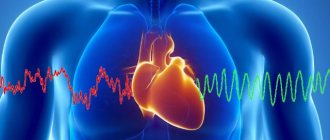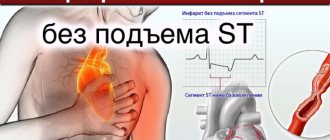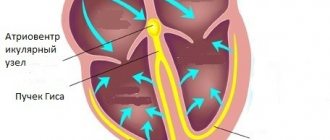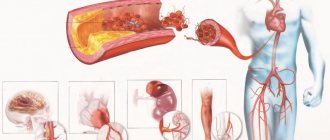What is left ventricular myocardial hypertrophy
Such a dangerous pathology of the heart is prone to lifelong transformation; its distinctive feature is the thickening of the myocardial wall with further dysfunction of the systemic blood flow. The abnormal process manifests itself in hypertensive patients, and its distribution completely depends on the type of anatomical structure of the heart muscle. There are several causes of this heart disease, but the doctor identifies the following pathogenic factors:
- hypertonic disease;
- heart disease;
- superphysical exercise;
- hereditary factor;
- anatomical features of the structure of the heart of a congenital nature;
- atherosclerosis of the aorta;
- professional athletes (this category of patients is concentrated in the risk group).
Symptoms of the disease
The disease has several degrees of development; accordingly, ECG signs of left ventricular hypertrophy at different stages will differ. The first stage of the disease is characterized by a high QRS amplitude, a positive T wave value, and the absence of ST segment displacement.
Manifestation of the disease on the electrocardiogram
As for the second stage of the disease, it is characterized by more serious changes, which can be manifested by a significant increase in the amplitude of the QRS complex, a decrease in the T wave, as well as a slight flatness of its shape. In addition, at the second stage, a displacement of the ST segment of a discordant type is observed.
The third degree of the disease is also characterized by an increase in the QRS complex, and it can be quite pronounced. There is also a discordant displacement of not only the ST segment, but also the T wave, the displacement occurs in relation to the QRS complex.
The fourth stage of the disease is considered the most complex and pronounced; accordingly, on the cardiogram it is displayed by pronounced and serious changes. At the fourth stage of hypertrophic lesion, a decrease in QRS amplitude of a secondary nature can be observed. In addition, repolarization disturbances occur, which are also characteristic of the third stage of the disease.
In addition to LVH, there may be a pathology such as left atrial hypertrophy, which is also quite pronounced on the electrocardiogram.
Signs of left ventricular hypertrophy on the ECG
Before starting treatment for left ventricular hypertrophy, the patient is shown a detailed diagnosis, which necessarily includes a cardiogram. Abnormal changes in the wall are clearly visualized on the screen, which leads to a failure of the systemic circulation and oxygen starvation. Some patients for a long time do not realize the existence of a terrible diagnosis in their own body, while others clearly feel pronounced signs of LVH on the ECG and in real life. Alarming symptoms are presented below:
- angina pectoris;
- arrhythmia;
- dizziness and weakness;
- short-term cardiac arrest;
- excessive swelling of the legs and arms;
- increased frequency of fainting;
- the appearance of attacks of shortness of breath;
- disturbance of the sleep and wakefulness phase;
- prolonged pressing pain in the heart;
- a sharp decline in performance.
Hypertrophy of the left ventricle of the heart on the ECG during myocardial excitation
This dangerous disease not only leads to a sharp jump in blood pressure, but there is also a risk of sudden death. This means that during one of the attacks the patient may die unexpectedly. Hypertrophy of the left ventricle of the heart on the ECG involves not only anatomical changes, but also the loss of the previous elasticity of the wall itself, nearby vessels, capillaries, and vascular elements.
As a result of this imbalance, ischemia of muscle cells rapidly progresses, disrupting the heart rhythm and blood flow to the suspected focus of pathology. The myocardium contracts abnormally, provoking frequent attacks of arrhythmia, angina pectoris, and hypertension. Among other complications of an increasing relapse, in addition to the unexpected death of a clinical patient, doctors identify the following life-threatening diagnoses:
- chronic heart failure;
- ventricular block and arrhythmia;
- heart attack;
- IBS.
Ideally, the mass of the left atrium exceeds the mass of the right atrium by almost 3 times. With hypertrophy, these norms are violated, and the focus of the pathology is characterized by sclerotic and dystrophic abnormalities. When the heart is excited, the ECG shows certain deviations from the norm, which immediately lead the specialist to alarming suspicions. It is especially worth paying attention to the following changes in the chosen diagnostic method:
- The right sternal leads demonstrate the following changes: the rV1 tooth is visible against the background of excitation of the interventricular septum, the SV1 tooth is visible against the background of excitation of the ventricle due to hypertrophy.
- Left sternal leads: visualization of the qV6 wave due to excessive activity of the interventricular septum, the RV6 wave due to hypertrophy of the left ventricle, the sV6 wave due to hyperexcitation of its base.
Hypertrophy of the left ventricular myocardium at the time of repolarization
Diagnosis using an electrocardiogram of the process of myocardial repolarization indicates the course of the pathology. During this period, the heart accumulates energy for the next contraction, but the process is abnormal against the background of altered myocardial boundaries. The problem has a conditional division that helps a specialist predict the most realistic clinical outcome. The types of cardiac repolarization as seen on the ECG are as follows:
- minimal (in 2-3 leads);
- moderate (at 4-6);
- maximum (from 6).
Structure and functions
The ventricles are formed by the heart muscle (myocardium). In this case, the medial wall of each of them is the interventricular septum, which separates the structures from each other. And they are separated from the atria by corresponding valves.
Atrioventricular valves perform not only a delimiting function, they also ensure unidirectional blood flow.
The right ventricle provides blood flow to the pulmonary circulation system, delivering venous blood to the lungs for the purpose of its oxygenation (oxygen saturation). If we talk about the corresponding left section, then it provides blood flow to the systemic circulatory system. That is, the delivery of oxygenated blood to all structures of our body.
The right ventricle has a wall thickness of 0.3–0.4 cm (normal). But the thickness of the left myocardium is 0.7–1.2 cm (normal). That is, the wall of the left heart is significantly thicker than the right, which is explained by the greater load on this section. After all, the myocardium of this chamber has to overcome greater resistance with each contraction, ensuring blood flow in the direction of the systemic circulation.
Quantitative signs of left ventricular hypertrophy
The electrical axis of the myocardium with hypertrophy of the left ventricle of the heart on the ECG is slightly deviated to the side or placed horizontally. A normal position is a rare occurrence, a semi-vertical position is extremely rare. Left ventricular hypertrophy on the ECG in a child and an adult is represented by quantitative signs that are visualized when diagnosing the heart. The manifestation of group A is as follows:
- EOS approaching to the left;
- RI from 10 mm;
- S(Q)aVR from 14 mm;
- TaVR from 0 with S(Q)aVR from RaVR reading;
- RV5, V6 from 16 mm;
- RaVL from 7 mm;
- TV5, V6 is less than or corresponds to 1 mm with RV5, V6 more than 10 mm and TV1-V4 more than 0;
- TV1 from TV6 (TV1 is greater than 1.5 mm).
Symptoms characteristic of group B:
- RI+SIII more than 20 mm;
- STI decline more than 0.5 mm (RI>SI);
- TI is less than or equal to 1 mm;
- with decline STI>0.5 mm and RI≥10 mm;
- TaVL below 1 mm;
- with a decrease in STaVL from 0.5 mm and RaVL more than 5 mm;
- SV1 from 12 mm;
- SV1+RV5 (V6) from 28 mm (up to 30 years);
- SV1+RV5(V6) from 30 mm (up to 30 years);
- QV4-V6 ≥ 2.5 mm at Q≤0.03 s;
- decline in STV5, V6 from 0.5 mm with a jump in STV3, V4;
- indicator R/TV5, V6 from 10 (TV5, V6 from 1 mm);
- RaVF over 20 mm;
- RII over 18 mm;
- activation period in leads V5, V6 from 0.05 s.
Complications of LVH
Moderate left ventricular hypertrophy is usually harmless. This is a compensatory reaction of the body designed to improve blood supply to organs and tissues. For a long time, a person may not notice hypertrophy, since it does not manifest itself in any way. As it progresses, the following may develop:
- myocardial ischemia, acute myocardial infarction,
- chronic cerebrovascular accidents, strokes,
- severe arrhythmias and sudden cardiac arrest.
Thus, left ventricular hypertrophy is a marker of cardiac overload and indicates the potential risks of cardiovascular disasters. Its combination with coronary heart disease is most unfavorable in the elderly and smokers with concomitant diabetes mellitus and metabolic syndrome (overweight and lipid metabolism disorders).
Classification by ECG for left ventricular hypertrophy
Author Romhilt-Estes characterizes LVH on the ECG using a five-point system. The evaluation criteria allow a complete clinical case to be examined for timely treatment of a progressive health problem:
- Branch V1: in the negative phase, the P wave, current from 0.04 s, corresponds to 3 points.
- Branch V6: presence of ST and T wave. When using glycosides, 1 point is added, in the absence of glycoside prescription - 3 points.
- Branches V5 and V6: periodicity from 0.05 s adds 1 point.
- The width of the QRS complex is greater than or equal to 0.09 s, 1 point is given.
- Deviation of the EOS to the left side is 30 degrees less than or equal to 2 points.
Voltage criteria on the ECG are decisive in identifying hypertrophy. R and S from 20 mm, the height of the S tooth in branches V1 and V2 is more than 30 mm, and R in V5-V6 is from 10 mm. For the presence of each sign - a bonus of 1 point. Large deviations from the norm require re-diagnosis, and for each increase 1 point is added to the total. This is an effective diagnostic tool that provides a clear picture of progressing pathology using the ECG.
Decoding
Myocardial hypertrophy, regardless of which part of the heart predominates, is always expressed in an increase in the excitation time and amplitude of the segments corresponding to the hypertrophied parts of the heart. For example, hypertrophy of the left atrium on the ECG is expressed by the growth and duration of P, and ventricular hypertrophy - by the QRS complex.
Blockade on the cardiogram - what is it?
In fact, myocardial hypertrophy is the main mechanism that compensates for increasing hemodynamic difficulties and develops when the blood-filled chambers of the heart are overloaded. Thus, the main signs characterizing hypertrophy are:
- an increase in myocardial mass, causing an increase in the electrical impulse, which as a result is expressed by deviations in the form of an increase in the cardiac vector in the direction of the hypertrophied ventricle (on the ECG this looks like an increase in the R wave);
- an increase in the number and length of myocardial muscle fibers, causing an increase in the transit time of the electrical signal along the hypertrophied wall of the ventricle, which on the ECG graph looks like an expansion or deformation of the QRS complex;
- uneven increase in muscle layer fragments disrupts repolarization processes (ST segment and T wave).
Depending on the place where the electrodes are fixed, all the teeth may have different directions. Therefore, when decoding the cardiogram, you should take into account the leads from which the data is read (thoracic region, left or right limb).
Table: Location of electrodes during an ECG study
| № | Lead | Electrode connection point | Electrode polarity |
| 1 | I | right upper limb | — |
| left upper limb | |||
| 2 | II | right upper limb | — |
| left lower limb | |||
| 3 | III | left upper limb | — |
| left lower limb | |||
| 4 | aνR | right upper limb | |
| 5 | aνL | left upper limb | |
| 6 | аνF | left lower limb | |
| 7 | ν1 | 4th intercostal space on the right | |
| 8 | ν2 | 4th intercostal space on the left | |
| 9 | ν3 | between ν1 and ν2 | |
| 10 | ν4 | 5th intercostal space at the level of the center of the clavicle | |
| 11 | ν5 | 5th intercostal space anterior axillary line on the left | |
| 12 | ν6 | 5th intercostal space mid-axillary line on the left |
Prevention measures
For preventive purposes, it is recommended to give up bad habits, such as smoking, lead a healthy, active lifestyle, and avoid stressful situations. Strength and vigorous sports are prohibited; it is better to replace them with walking or swimming. It is also necessary to monitor blood pressure, take preventive medications and undergo regular examinations with a cardiologist. Sick people prone to obesity or diabetes need to adhere to a special diet prescribed by their doctor.
The success of treatment and prevention of the disease are largely determined by:
- giving up bad habits;
- moderate physical activity;
- an optimal diet rich in vitamins, fiber, calcium, magnesium, vegetable fats with a minimum of sugars, salt, fat, and baked goods.
People who have had such a disease should undergo periodic follow-up visits with a cardiologist.
The following foods should be excluded from the diet of patients:
- containing a significant amount of animal fats;
- sweets;
- bakery products;
- limit salt intake.
The following products should be included in large quantities:
- dairy products;
- fruits and vegetables;
- seafood.











